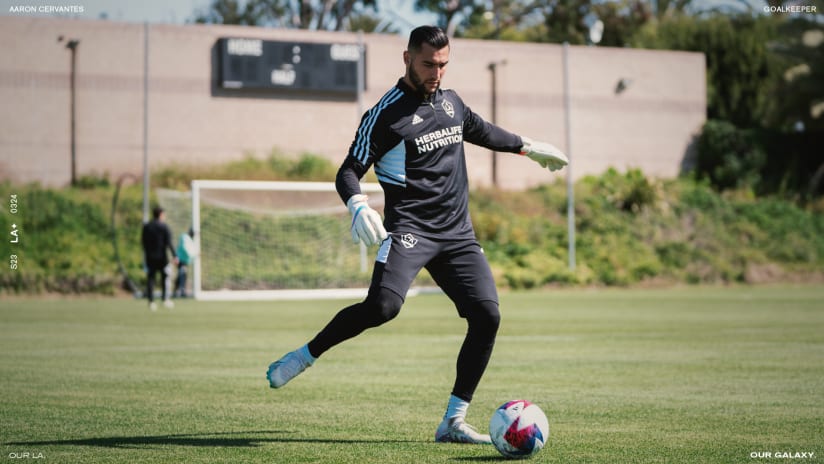CARSON, Calif. -- It starts with the weather.
Southern California is something close to paradise, with year-round sun and cool ocean breezes making for a perfect climate that for nearly a century has lured millions from throughout the U.S. and around the world.
It adds up, rising to some 22 million people across the seven SoCal counties these days, including significant immigrant communities from, well, everywhere -- several of them richly influencing the region's culture.

Right there are the ingredients to SoCal's soccer boom, which was born with the American Youth Soccer Association's formation a half-century ago and has established the area from Santa Barbara to the Mexican border as the most fertile proving ground for U.S. talent since the arrival of the American game's modern era with the 1990 World Cup and all that followed over the next decade.
The biggest names in U.S. national team history? There's Cobi and Cal, Waldo and Landon, 'Celo and Ricky, Julie and Joy -- all of them SoCal boys and girls.
“I think Southern California always had an advantage over the rest of the country, because they have the opportunity to train and play year-round, because of the climate,” said Galaxy head coach/general manager Bruce Arena, who leaned heavily on SoCal talent during his stint as U.S. national team coach from 1998 through the 2006 World Cup. “The chances of coming out of here and reaching a higher level is probably more favorable for kids out of Southern California, and I think we see a little bit of that with the youth national teams and all of that. It's a good environment for players to develop.”
Unquestionably so.
The list of Southern Californians who have had impressive careers with U.S. Soccer goes on and on and on.
Most caps for the U.S. men's team? That would be Galaxy legend Cobi Jones, with 164 (and three World Cups). He's from Westlake, on the L.A./Ventura counties border.
Most goals? Assists? That, of course, is Galaxy legend Landon Donovan, who scored 57 international goals with 58 assists -- he's the all-time MLS leader at both, too -- while playing in three World Cups. He's from Redlands, out in San Bernardino County.

The man who held the U.S. goals record before Donovan? Eric “Waldo” Wynalda, another World Cup star who grew up in the same neighborhood as Cobi Jones, his Westlake High School teammate.
Paul “Cal” Caligiuri, whose “shot heard 'round the world” sent the Yanks to the 1990 World Cup -- their first in 40 years -- and more or less kicked off the modern era of the sport in this country? The former Galaxy defender is from Walnut.
Ricky Davis, who signed as a teen with the legendary Cosmos and was America's biggest soccer star of the 1970’s? Claremont's his hometown.
All of these except Donovan, who'll be there shortly, are enshrined in the National Soccer Hall of Fame. So are Marcelo “ 'Celo” Balboa (Cerritos) and Joe-Max Moore (Irvine), who both played in three World Cups apiece. And Hugo Perez (Los Angeles), who was on the 1994 World Cup squad.
Then there's Julie Foudy (Mission Viejo), Joy Biefeld Fawcett (Huntington Beach) and Carin Jennings Gabarra (Rancho Palos Verdes), who starred for the first Women's World Cup champions in 1991 and first Olympic women's soccer gold medalists in 1996. Foudy and Fawcett played in four World Cups and three Olympics. All three are in the Hall, too.
That's just for starters. Who else developed on SoCal pitches? How about future Hall-of-Famer Steve Cherundolo (Poway), 2010 World Cup captain Carlos Bocanegra (Rancho Cucamonga) and John O'Brien (Playa del Rey), who reached his prime at Ajax Amsterdam and might be the most talented man ever to pull on a U.S. jersey?
Don't forget Shannon Boxx (Redondo Beach), who redefined the holding midfield position for the U.S. women -- and is headed to her fourth World Cup this summer. Nor Alex Morgan (Diamond Bar), the explosive striker who has emerged as face of the current U.S. women's team seeking its first World Cup crown since that glorious summer of 1999.
Three other L.A.-area women -- Whitney Engen (Rolling Hills Estates), Christen Press (Palos Verdes Estates) and Amy Rodriguez (Lake Forest) -- also are headed to Canada for the 2015 Women's World Cup. Head coach Jill Ellis has been in SoCal for years, building UCLA's women's team into a national powerhouse.
U.S. coach Jurgen Klinsmann, who lives in Orange County, has several local boys in his pool, from Galaxy striker Gyasi Zardes (Hawthorne) to Real Salt Lake goalkeeper Nick Rimando (Montclair), the only SoCal product on the 2014 World Cup roster.

“Southern California has always been -- I know this is a corny word -- a hotbed for soccer talent,” says Peter Vagenas (Pasadena), a 2000 Olympian who captained the Galaxy to their 2005 MLS Cup triumph and now runs the club's innovative Academy. “You see players from California littered on professional teams, national teams, youth national teams.”
And you always have, at least since the 1980s.
The best players from SoCal have had characteristics that often separated them from their counterparts from elsewhere in the U.S.
“There was no question that players from Southern California had a different skill set in terms of technique or a comfort level with a soccer ball,” said former Galaxy midfielder Jorge Salcedo (Cerritos), who coaches his alma mater UCLA's perennially powerful men's soccer program. “And I think a lot of it has to do with the elements here: the weather, the fields, the different influences from around the world. So much of my peers' skill sets were based around their technique and their ability to pass and trap the soccer ball.”
Balboa, who was a few years ahead of Salcedo at Cerritos High School, saw the same things.
“There's a ton of advantages [in Southern California],” said the central defender, the first U.S. player to reach 100 caps. “The fact that you've got sun 365 days out of the year, you can play soccer all year-round; the competition, because it's such a big state and so many kids are playing soccer.
“I live in Colorado now, and we can't play year-round. And that's a huge disadvantage for our kids.”
Before the mid-1970s, soccer was largely a foreign sport in Southern California. There were ethnic clubs, with some decent players, but U.S. Soccer looked to St. Louis, Philadelphia, New Jersey and New England for talent.
“When I was growing up, every nationality had their own club,” said German-born Seattle Sounders head coach Sigi Schmid (Torrance), who played and coached at UCLA, guiding the Bruins to three NCAA titles before coming to MLS, first as the Galaxy's head coach from 1999 through 2004. “There were two or three German clubs, the Magyar Hungarians had a club, the Armenians, the Yugoslavs, the Croatians, the Italians.
“There was some good soccer being played back in those days, when I was a kid. I watched games, and there were guys who could play.”
The best might have been Albert Zerhusen, a Brooklyn-born midfielder who captained the L.A. Kickers, a German team, for a decade. He and Danish-born goalkeeper Sven Engedal, from Long Beach, were the first Southern California-based players to play for the national team.
Zerhusen, a Hall-of-Famer, played for the U.S. until the mid-1960s.
Hungarian-born Helmut Bicek, who scored in draws against Mexico in 1962 and 1966, and Nicaragua native Bayardo Abaunza played for the U.S. in the '60s, and a couple more -- Dave Coskunian and Hank Liotart -- received call-ups in the 1970s, and Hugo Salcedo (Jorge's father) and Steve Gay made it to the 1972 Munich Olympics.
Ricky Davis, who would make 35 international appearances and play in the 1984 Los Angeles Olympics, was the first locally born player with the full national team when he debuted in 1977.
That's when things began to change, but the foundation was cemented in 1964, when the AYSO brought soccer to America's suburbs, starting in the South Bay. Schmid, then 11, was one of the first kids to sign up, and Bicek was his first AYSO coach.
“That started to get American families into the sport and established, I guess you would call it, a recruiting base,” said Schmid, who will be inducted into the Hall of Fame later this year. “And from that came more structured club soccer with the California Youth Soccer Association [starting in 1974].”
Soccer spread from the South Bay into Orange County and San Diego, then into the San Fernando Valley and Simi Valley, the San Gabriel Valley and finally the Inland Empire.
Southern California became the dominant region in American youth soccer, with 64 national championships spread among its clubs -- 13 in the last two years -- far more than every other state association. SoCal teams have won 164 of 288 Region IV titles since 1997, with 101 of 160 in the past 10 years.

Schmid took charge at UCLA, which had a tradition of strong foreign talent, in 1980 with a clear objective.
“When I went to UCLA, I was the only American on the team -- the only citizen -- and one of my goals was that I wanted to win with American players and show that Californians could play soccer, that we had good players here,” he said. “And that first [UCLA] team that won a championship, in '85, I think we had all Californians on the team, with one exception.”
That Bruins team featured Caligiuri, Paul Krumpe (Torrance) and David Vanole (Redondo Beach), who were part of the 1990 World Cup team, plus Dale Ervine (Torrance) and Eric Biefeld (Huntington Beach), who also were capped by the U.S. national team.
Biefeld and Fawcett are the only brother-sister combination the full U.S. national teams have seen.
Another star from that team was Mike Getchell, a Northern California product who would go on to play professionally in Mexico. Wynalda loved to watch him play for the Bruins.
“So smooth,” Wynalda said. “I wore 17 in high school because of him. We met once, and he couldn't believe that I idolized him as a kid.”
The soccer establishment couldn't help but notice these SoCal kids. They were different.
“I think you always found players in Southern California that had more of an instinctive side to the game, who were a little more creative,” Schmid said. “The back-East style was a little more 'we're going to grind it out, we're going to be a little more physical, a little bit stronger,' and that's not to say Southern California didn't have some of those players. Caligiuri certainly could play physical, and Mike Lapper was a strong player. But then we also had the Joe-Max Moores, guys that had that flair and creativity.”
Southern Californians were pivotal as the U.S. started taking soccer seriously. The 1990 World Cup team had Caligiuri, Balboa, Krumpe, Vanole and Wynalda, plus UCLA products Brad Friedel and Chris Henderson.

There were eight on the 1994 team, which prepared for the World Cup with an 18-month Mission Viejo residency: Jones, Caligiuri, Balboa, Wynalda, Perez, Moore, Lapper (Huntington Beach) and Cle Kooiman (Ontario). Frankie Hejduk (Cardiff-by-the-Sea) was on board in 1998, and the 2002 team featured Cherundolo, Donovan, O'Brien and Eddie Lewis (Cerritos), in addition to Jones and Moore.
Bocanegra and Jimmy Conrad (Temple City) were part of the 2006 side, and Benny Feilhaber (Irvine), Jonathan Bornstein (Los Alamitos) and Maurice Edu (Fontana) were in the 2010 squad.
Others made it to the Olympics, including Galaxy technical director Jovan Kirovski (Escondido) and left back Robbie Rogers (Huntington Beach), plus Mike Fox (Covina), Jeff Hooker (Walnut), Marvell Wynne (Poway), Cam Rast (Simi Valley) and Yari Allnut (San Diego).
The team that played for bronze at the 2000 Sydney Olympics included Donovan, O'Brien, Hejduk, Vagenas, Danny Califf (Orange), Joey DiGiamarino (Corona) and Brian Dunseth (Upland).
Other SoCal products include Ante Razov (Fontana), one of eight men with 100 or more MLS goals, and Matt Reis (Mission Viejo), now the Galaxy's goalkeeper coach. They're among 70 UCLA players to make it to America's top league -- no other college has produced more.
The U.S. women began play in the mid-'80s and found success as Anson Dorrance, the team's second head coach, began bringing in young talent. Included in that group were Gabarra, who had starred at UC Santa Barbara, and Fawcett and Foudy, then high-schoolers.

Part of Foudy's workout regimen involved short-sided games with Moore, her classmate at Mission Viejo High School.
“Next to our big basketball gym, we had an adjoining, small guy that had padded walls. Literally, the size of an indoor field,” Foudy said. “And we would get the key, because one of our buddies was the janitor, and we'd got at night and play 4v4 all the time. This is all through college, as well.
“I liked that you had to play fast, and we would go all night. It was crazy. Man, I miss that.”
Other SoCal women to play in the Women's World Cup were Shannon MacMillan (Escondido), who played in two World Cups and two Olympics, Jen Lalor (Chula Vista), Nikki Serlenga (Escondido) and Rachel Buehler Van Hollebeke (Del Mar).
The Galaxy, too, has always leaned heavily on local talent. Jones was LA’s first player, signed ahead of the inaugural 1996 season, and Caligiuri, goalkeeper Kevin Hartman (Palos Verdes Estates) and midfielder Danny Pena (Culver City) made huge contributions starting in 1997.
Kirovski played two stints with LA, and Hejduk, Lewis and Califf also are alumni. Sean Franklin (Palmdale) was Rookie of the Year in 2008. The current team has 11 SoCal products: Zardes, Rogers, Alan Gordon (Long Beach), Rafael Garcia (Canoga Park), Brian Perk (Rancho Santa Margarita) and Trey Mitchell (Alta Loma), plus homegrown players Jose Villarreal (Inglewood), Bradford Jamieson IV (Los Angeles), Jack McBean (Newport Beach), Raul Mendiola (Alta Loma) and Oscar Sorto (Los Angeles).

There are hundreds more in the Galaxy Academy, working toward the Galaxy II side that plays in the USL and on to the first team, just like Zardes, Villarreal and others before them.
“I can say we have never been so excited about not only the amount of quality that we have at our younger ages, but also players we believe [have the potential] to be really special,” Vagenas said. “A game-changer, the one who breaks the trend.
“We're at the forefront [of development], and for me, in terms of what the Galaxy have done, you ain't seen nothing yet. You're going to see something spectacular coming from this Academy.”




